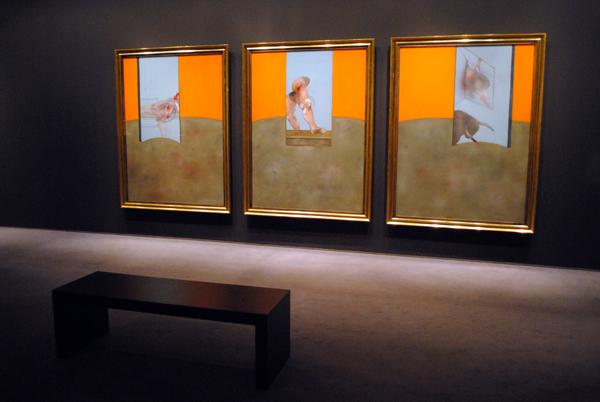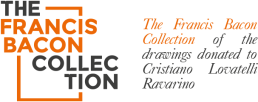April 22, 2015

Francis Bacon and the Masters is the latest exhibition of works by the late-great British painter, bringing together over twenty-five major works by Bacon and juxtaposing them with old and modern masters, including Velázquez, Rembrandt, Titian, Michelangelo, Rodin, Van Gogh, Picasso and Matisse. Francis Bacon and the Masters forms the culmination of the celebrations marking the 250th anniversary of the State Hermitage Museum, St Petersburg, and coincides with the UK/Russia Year of Culture in the UK.
The previous exhibition at The Hermitage Museum brought to an end its 250th anniversary celebrations, and showed the artist’s work from UK collections alongside objects from the Hermitage that inspired him. The exhibition included an equally impressive twenty-five canvases. The paintings were part of an exhibition ‘Francis Bacon and the Art of the Past’ that was on display at the newly reconstructed General Staff building.
The current exhibition again explores Bacon’s obsession with the art of the past, examining how he consistently drew on the work of masters such as Michelangelo, Velázquez and Degas, as well as to the stylised forms of ancient Greek and Roman works. The exhibition will continue the idea of comparing Bacon’s work with works of historical note. Director of the State Hermitage Museum, art historian, and curator of the exhibition, Dr. Thierry Morel was kind enough to give Artlyst a tour of this latest exploration of Bacon’s visceral oeuvre.
“When looking at Bacon’s van Gogh series what they illustrate is how talented a colourist Bacon was. The vibrant blue, green red, yellow – I think it’s an explosion of colours – and of course van Gogh also – when you look at the contrast between his works in the Hague period when he was rather vain, and moody – and muted [Peasant Woman Digging, 1885] – and this is quite a moving story – is they were inspired by pictures by Millet. So you see, you had van Gogh painting compositions very similar to those of Millet – and then afterwards Bacon is doing the same. It’s a journey through history, and the fact that many artists do that – Rodin did it, I mean Michaelangelo inspired so many, Raphael and so forth – and here is the painting [a reproduction of ‘Painter on the Road to Tarascon’, 1888] the series [by Bacon] was based on – as you know he spent quite a lot of years in Berlin, and so that painting was in Berlin, and it was destroyed in Berlin at the end of the war in 1944, so it’s gone!
At The Hermitage we had another work very close to that one, a figure walking as well, with a hat – a farmer walking – but sadly that picture couldn’t come as it is too fragile to travel, but you’ll see it in the catalogue, and is directly related to this. Also with van Gogh, Bacon had an intellectual relationship in terms of the fact that he had the conversations and letters between Theo and van Gogh – which are fascinating, and illustrate the solitude, the tragedy of being an artist, the uncertainties of life, and also the self doubt. How many canvases has Bacon destroyed? How canvases has van Gogh destroyed? They both had the burst of pride and joy, and drunkenness, interspersed with completely dark moments in the studio. But what they also share is a breath of hope I think; it’s cathartic, and in a way the tragedy, the sadness of those ‘tortures’, those aspects of his pictures were one way of releasing himself from this torture.
Also at The Hermitage we explored the figures ranging between van Gogh’s figures and those of Bacon; but in this selection there is a stress on the landscape, the colours and the palette, and also the treatment of the vegetation: you can see emerging from the earth; it’s discursive, giving you an idea of what a landscape is, but by doing that it is actually more realistic than if it was by a photographic artist.
And then we come to Picasso, [‘A Young Lady’] it’s a fantastic 1909 Cubist painting, one of the great masterpieces of the Hermitage [juxtaposed with Portrait Of Issabel Rawsthorne, 1966]. Here these two works are particularly evocative of Bacon’s use of Picasso – the fragmentation, that fascinated him and the fragments of ancient art, but also in the way Picasso decomposes – Cézanne as well – decomposes nature and figures into shapes, into geometrical shapes – while still capturing the soul of whoever they are trying to portray. With Bacon the forms merge but it’s about curves, with Picasso it is a more angular structure. But the way Picasso played with noses, you see this mirrored in Bacon, who saw one of Picasso’s most important exhibitions in Paris in the Rosenberg Gallery, which had a huge impression, which he spoke a lot about in the David Sylvester interviews.
We have the series of screaming popes, and Bacon’s connection to Velázquez, but what is less known is – a very good example of the fact that Bacon wasn’t just inspired by a single artist, or by a single painting – but it is in fact a Kaleidoscope of images, so in his mind, on one side you have images from the film ‘The Battleship Potemkin’ and the screaming nurse – but actually the origin of these screaming figures is neither the Velázquez nor Potemkin – it’s actually Poussin’s The Massacre Of The Innocents, which is in Chantilly. When he was sixteen he spent three months in Chantilly and went to see the collection at the Château de Chantilly, and that’s where he saw the painting. Bacon thought it was the most powerful expression of human sorrow – and that’s how he got this idea of screams.
Then we have the book on the diseases of the mouth, illustrated and hand-painted, gruesome. I know someone who knew Bacon and went to his studio, and he was quite shocked by what he saw – he was a young impressionable man – and to add to this Bacon said ‘look at this…’ and showed him this gruesome book of horrible bloody images of the mouth.
But Bacon also contradicts himself sometimes. David Sylvester said that he chose the Pope – because it’s the Pope! Bacon said no it was because Velázquez’s ‘Innocent X’ was the most powerful picture ever created, so he did it out of love for that painting not because it was the Pope – to which Sylvester questioned why he portrayed other popes? to which Bacon replied ‘that’s true…’ So Sylvester goes on and talks of the solitude of the Pope and his position of facing Christ on the one-hand and the crowd on the other, and what he represents for millions – so in the end Bacon acquiesced. I don’t think Bacon was trying to hide or to pretend other things, I think sometimes you forget, and that’s the point as I think this show is also and above all about memory, about the power of images that come straight to your mind, and then you forget about them – and then suddenly they re-emerge years later and are expressed in other ways. For the public I think they’ll find it fascinating how memory plays tricks with you – and what in the end stays in your mind.”
Words: Thierry Morel with Paul Black. Photos and Vine: P A Black © Artlyst 2015 all rights reserved
Francis Bacon And The Masters – Sainsbury Centre For Visual Arts – until 26 July 2015
